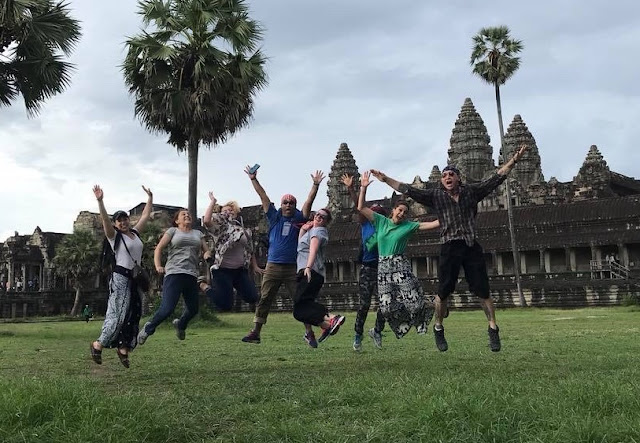 |
| Shackles from S21 |
Our last day in Cambodia was the hardest, even though our physical labor was done. We took a bus to Phnom Penh, where we visited the S21 prison and the Choeung Ek killing fields.
I didn't expect the day to affect me the way it did. I already knew that a million and a half people were executed by the Khmer Rouge in a four-year period, and that thousands of them were imprisoned and tortured at the S21 prison.
 |
| Tiny cells on the first floor of S21, formerly a school, were built of brick. |
 |
| On the second floor, cells were even smaller and built of wood, to accommodate the swelling prison population. |
 |
| On the third floor, cells were dispensed with, and prisoners were chained to the wall in numbered rows. |
I already knew that nearly 9,000 bodies were discovered at Choeung Ek in mass graves.
 |
| Depressions in the ground show where mass graves were excavated at Choeung Ek. |
I already knew that mounds of skulls and bones were displayed in the site's stupa.
 |
| Photos by Everywhere Once |
I even knew about how prisoners were tortured and babies were murdered, because I'd read about Cambodia before leaving home, as part of Kirkwood's study-abroad class.
 |
| Executioners held babies by their feet and smashed them against this tree before swiveling to toss them in the mass grave to the right, now fenced and roofed as a memorial. |
But what I didn't know was that our tour guide for the day, Mr. Kim Boral, would himself be a survivor of the genocide. And that he would be exactly my age.
I had imagined what it would have been like if I'd been born in Cambodia rather than in the US. But when Boral told his story, I didn't have to imagine anymore; I could just listen.
Boral's family lived in Phnom Penh. His father was a doctor who spoke four languages, which made him a target of the communist Khmer Rouge regime. When Pol Pot took over in 1975, Boral's father was arrested, and Boral never saw him again. He later heard that his father was executed and buried deep in the jungle with other prisoners, but he and his family have never found the location.
I knew that my own father, an engineer and corporate executive, would have met the same fate. My dad had died almost exactly a year before I met Boral. He had seemed far too young when he died, and I was missing him terribly on my trip to Cambodia. But I'd had him forty-three years longer than Boral had had his father--and I didn't have to wonder about how he'd been tortured, where (and if) he'd been buried.
After his father's arrest, Boral and the rest of his family were forced to evacuate Phnom Penh on foot. He was four years old. His uncle and grandfather took turns carrying him on their backs.
They were marched to a labor camp in the country where the family was split up--his mother with the women, his grandfather and uncle with the men, and Boral with the children. Even as a four-year-old, he was forced to work all day in appalling conditions. His job was to collect manure from swampy pits, to be dried and burned as fuel. Boral pulled up his pants to show us the scars on his legs from abscesses he developed walking all day in raw sewage.
 |
| Boral shows us injuries to his head and legs from his time at a Khmer Rouge labor camp. |
There was never enough food. When his mother or uncle was able to exchange a few words with him, they instructed him how to forage for morning-glory leaves and other plants to avoid starvation. They also told him what not to eat. At Choeung Ek, Boral showed us a tree with fruit that will kill a man in two hours.
By the time the Khmer Rouge fell in 1979, most of Boral's family had died in the labor camp of disease or starvation. He and his mother survived, but he mentioned many times how his mother had suffered since then, from depression and PTSD.
I asked Boral why he wanted to be a tour guide--why he would willingly subject himself to revisiting these scenes of torture, imprisonment, execution, and inhumanity over and over again. He said that he wants foreigners to know what happened in Cambodia. He doesn't want the genocide to be forgotten.
At the end of our tour, I complimented Boral on his English. "You must have gotten your skill with languages from your dad," I said. He smiled and replied humbly, "No, I'm not as good as him. He spoke four languages. I only speak three."















































